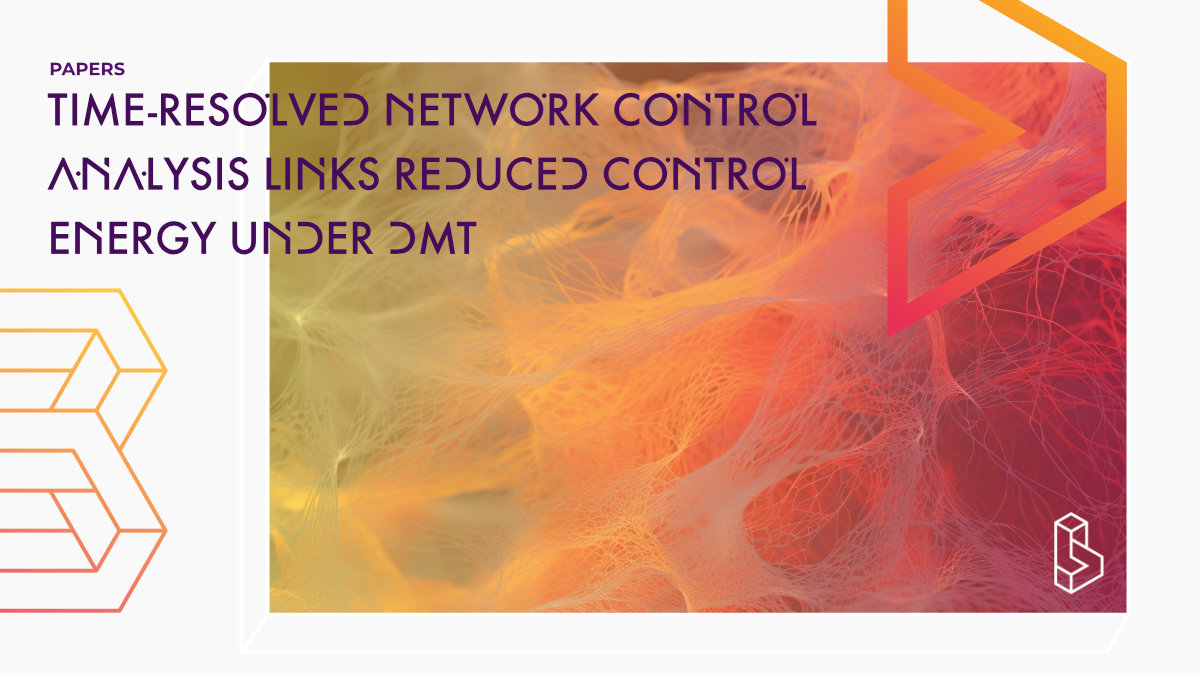This re-analysis (n=14) applies a receptor-informed network control theory framework to investigate the effects of DMT on the brain’s control energy landscape. It reveals that DMT, like LSD and psilocybin, reduces global control energy, with these trajectories correlating with EEG signal diversity and subjective intensity ratings. Furthermore, the regional effects of DMT correlate with serotonin 2a receptor density, demonstrating a potential proof-of-concept for predicting pharmacological intervention effects on brain dynamics using control models.
Abstract of Network control energy reductions under DMT relate to serotonin receptors, signal diversity, and subjective experience
“Psychedelics offer a profound window into the human brain through their robust effects on perception, subjective experience, and brain activity patterns. The serotonergic psychedelic N,N-dimethyltryptamine (DMT) induces a profoundly immersive altered state of consciousness lasting under 20 min, allowing the entire experience to be captured during a single functional magnetic resonance imaging (fMRI) scan. Using network control theory, we map energy trajectories of 14 individuals undergoing fMRI during DMT and placebo. We find that global control energy is reduced after DMT injection compared to placebo. Longitudinal trajectories of global control energy correlate with longitudinal trajectories of electroencephalography (EEG) signal diversity (a measure of entropy) and subjective drug intensity ratings. At the regional level, spatial patterns of DMT’s effects on these metrics correlate with serotonin 2a receptor density from positron emission tomography (PET) data. Using receptor distribution and pharmacokinetic information, we recapitulate DMT’s effects on global control energy trajectories, demonstrating control models can predict pharmacological effects on brain dynamics.”
Authors: S. Parker Singleton, Christopher Timmermann, Andrea I. Luppi, Emma Eckernäs, Leor Roseman, Robin L. Carhart-Harris & Amy Kuceyeski
Summary of Network control energy reductions under DMT relate to serotonin receptors, signal diversity, and subjective experience
Serotonergic psychedelics such as LSD, psilocybin, and DMT are powerful neuromodulators that transiently alter the human experience. MAO enzymes metabolise DMT in the body and, therefore, must be combined with MAO inhibitors to be orally active.
Human neuroimaging studies with LSD and psilocybin have demonstrated that these compounds acutely decrease integrity within the brian’s functional sub-networks, while increasing integrity between functional sub-networks. This finding affords a unique opportunity to model and study the perturbation of brain dynamics using whole-brain computational models.
Network control theory is a linear dynamical systems approach that models state transitions occurring within a network. It has been applied to the brain in various cognitive states and neuropsychiatric/degenerative conditions, as well as throughout development and during neuromodulation and pharmacologically induced altered states.
Find this paper
https://doi.org/10.1038/s42003-025-08078-9
Open Access | Google Scholar | Backup | 🕊
Cite this paper (APA)
Singleton, S. P., Timmermann, C., Luppi, A. I., Eckernäs, E., Roseman, L., Carhart-Harris, R. L., & Kuceyeski, A. (2025). Network control energy reductions under DMT relate to serotonin receptors, signal diversity, and subjective experience. Communications Biology, 8(1), 631.
Study details
Compounds studied
DMT
Topics studied
Neuroscience
Healthy Subjects
Study characteristics
Original Re-analysis
Placebo-Controlled
Single-Blind
Within-Subject
Randomized
Participants
14
Humans
Authors
Authors associated with this publication with profiles on Blossom
Chris TimmermannChris Timmerman is a postdoc at Imperial College London. His research is mostly focussed on DMT.
Robin Carhart-Harris
Dr. Robin Carhart-Harris is the Founding Director of the Neuroscape Psychedelics Division at UCSF. Previously he led the Psychedelic group at Imperial College London.
Institutes
Institutes associated with this publication
Imperial College LondonThe Centre for Psychedelic Research studies the action (in the brain) and clinical use of psychedelics, with a focus on depression.
Compound Details
The psychedelics given at which dose and how many times
DMT 20 mg | 1xLinked Research Papers
Notable research papers that build on or are influenced by this paper
Time-resolved neural and experience dynamics of medium- and high-dose DMTThis repeated-measures dose-dependent study (n=19) investigates DMT's subjective and neural dynamics under naturalistic conditions. Participants received 20mg or 40mg doses of freebase DMT in a blinded, counterbalanced design, with EEG data and time-resolved subjective measures collected. The 40mg dose produced more intense visual hallucinations and emotional responses. Neural analyses revealed alpha power and permutation entropy were most associated with subjective experiences, whereas lempel-ziv complexity was less predictive, challenging prior assumptions about its role in psychedelic states.
Autonomic nervous system activity correlates with peak experiences induced by DMT and predicts increases in well-being
This re-analysis of a single-blind study (n=17) investigates the role of the autonomic nervous system in DMT-induced peak experiences (20mg, iv). It finds that balanced activity between the "fight-or-flight" and "rest-and-digest" systems (sympathovagal coactivation) is linked to stronger feelings of spirituality and insight during DMT sessions and improved well-being two weeks later. The study also notes that a person's nervous system (sympathovagal) balance before taking DMT can predict how insightful their experience will be.
Brain substates induced by DMT relate to sympathetic output and meaningfulness of the experience
This pre-print single-blind study (n=14) used multimodal neuroimaging techniques (fMRI + EKG) to investigate brain activity and autonomic physiology during DMT (20mg) altered state of consciousness. Results reveal unique brain activity substates, with increased superior temporal lobe activity and hippocampal deactivation under DMT, correlating with auditory distortions and meaningfulness of the experience, respectively. Moreover, increased heart rate under DMT correlates with hippocampal and medial parietal deactivation, suggesting a potential link between sympathetic regulation and positive mental health outcomes following psychedelic administration.
Human brain effects of DMT assessed via EEG-fMRI
This neuroimaging study (n=20) aimed to understand the effects of DMT (20mg) on the human brain. The researchers used EEG-fMRI (electroencephalography-functional MRI) to measure brain activity before, during, and after administering DMT to healthy volunteers. They found that DMT increased global functional connectivity (GFC), network disintegration and desegregation, and a compression of the principal cortical gradient.

